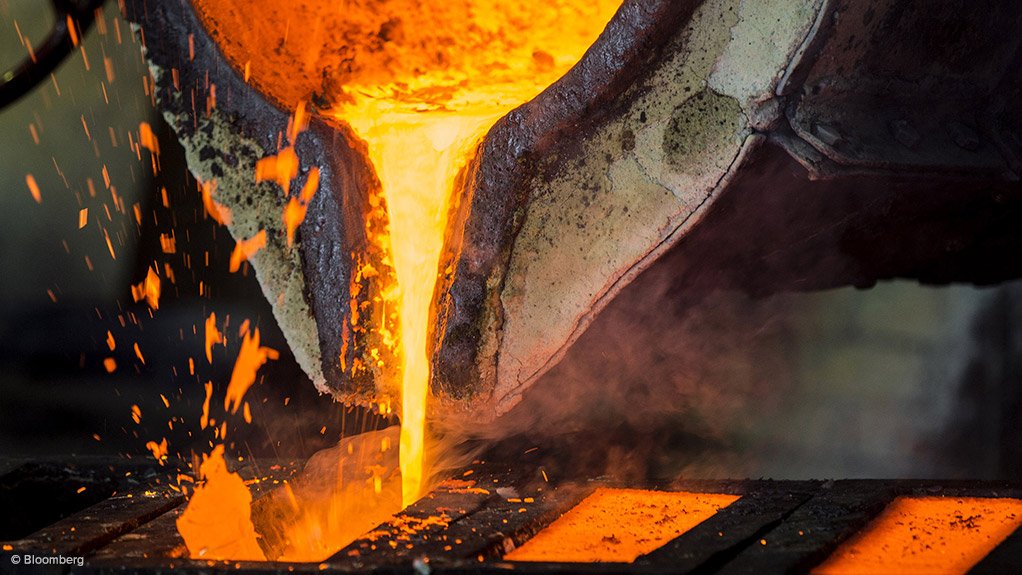VANCOUVER (miningweekly.com) – Only about one-third of the 15 largest copper producers with output of more than 40 000 t of copper per quarter reported positive production trends during the first quarter of this year, driving quarter-on-quarter output 4.8% or 136 548 t lower, a new report by S&P Global has found.
However, on an annual basis, output rose by 14.8%, or 345 725 t, in the March quarter.
According to S&P Global, the top two companies reporting the largest year-on-year production gains in the first quarter were BHP Billiton and Rio Tinto, which have 57.5% and 30% stakes in Escondida, respectively.
BHP's 229 900 t and Rio Tinto's 55 100 t year-on-year increase in reported output were mainly driven by the resumption of normal operations at Escondida. In the first quarter of 2017, Escondida's production fell to 94 900 t of contained copper on the back of a strike by union workers. By contrast, first-quarter 2018 output at Escondida totalled 322 000 t, more than triple the output in the first quarter of 2017.
S&P Global pointed out that BHP's stronger first-quarter performance was also boosted by increased output at its 33.8% owned Antamina mine; its share of production was up to 35 200 t, from 29 200 t in the first quarter of 2017, and 33 800 t in the fourth quarter of 2017. Despite being virtually flat year-on-year, Olympic Dam's production more than tripled to 40 500 t quarter-on-quarter, as the mine ramped up production following a smelter maintenance campaign that had lowered production to 12 200 t in the fourth quarter of 2017. However, BHP did lower its production guidance for Olympic Dam owing to the ramp-up in production taking longer than expected.
Escondida's increased output offset lower output at Rio Tinto's Kennecott mine, where production fell 20% year-on-year, mainly owing to lower head grades. It also offset a quarter-on-quarter decline in production at Oyu Tolgoi, in Mongolia, arising from a planned plant shutdown in January.
Rio Tinto has a joint venture agreement with Freeport-McMoRan, with Rio Tinto entitled to a 40% share of Grasberg's production above an agreed threshold until the end of 2021. However, Rio Tinto's full participation has been delayed due to the application of force majeure provisions in the joint venture agreement.
Rio Tinto was, therefore, unable to benefit from increased copper output from the Indonesian mine, which saw output double year-on-year to 311-million pounds in the first quarter. The increase was because, in the first quarter of 2017, a ban on concentrate exports coincided with a strike at Gresik. As stockpiles reached capacity, Freeport was forced to curtail concentrate production at the mine site.
Now that normal production has resumed, Freeport, which has a 90.64% stake in Grasberg, saw its copper output increase 13.1% year-on-year, or 41 277 t, in the first quarter. The increase in Grasberg's production offset a decline in output from its Chino, Morenci and Safford operations in the US and from Cerro Verde, in Chile.
On a quarterly basis, however, Freeport's production fell by 5.9%, or 22 226 t. This was primarily owing to Grasberg, where maintenance activities on the ore flow systems and the characteristics of the ore processed during the quarter resulted in lower-than-expected mill throughput.
Glencore reported the fourth-largest year-on-year increase in its own-sourced copper output, which was up 6.6% year over year, or 21 300 t. This was owing to the commissioning of Phase 1 of Kamoto's whole ore leach project in December 2017. This was partly offset by the impact of maintenance at Mt Isa and Alumbrera's expected decline in output as it moves toward the end of its life.
Norilsk Nickel is the second company, after BHP, to have reported higher production both year-on-year and quarter-on-quarter, up 21.6% and 1.2%, respectively, to 111 515 t, S&P pointed out. This was mainly attributable to the first batch of copper concentrate produced during the hot metal commissioning stage at Bystrinskoye. However, production targets for the project in 2018 have been scaled down owing to ramp-up issues. The company reported in April that the first rail shipment from the plant had been sent across the Chinese border.
KAZ Minerals' output also improved on both an annual and quarterly comparison, to 92 900 t. This was also due to strong performance at its Aktogay and Bozshakol operations in Kazakhstan, which commenced production in the fourth quarter of 2015 and the first quarter of 2017, respectively.
Five companies reported lower production on a quarterly and annual comparison, namely MMG, Grupo México, Antofagasta, Vale and KGHM Polska Miedź.
BEARISH SENTIMENT
On Thursday, copper fell 2.2% to $6 877/t, compared with $6 919/t on Wednesday, following US President Donald Trump tempering early optimism on closing a US–China trade stand-off, which hindered appetite for cyclical assets and drew the metal from one-month highs.
Comments backtrack from US Treasury Secretary Steven Mnuchin’s announcement that the prospect of a trade war between the two countries was “on hold”, giving a boost to nominally riskier assets like stocks and industrial metals.
Copper is identified as the “commodity most leveraged to the global economic cycle”, with the price retracing highlighting growing pessimism surrounding global economic health, analysts at London-based boutique broker SP Angel said on Thursday.
“A coordinated surge in global manufacturing supported copper prices to gain 31% last year, the best performance since 2009. However, faltering demand in factory output is drawing prices 5.2% lower for the year-to-date. Further, in the US, the purchase of new homes fell in April, signalled weaker demand for the metal used in pipes and wires.”
Edited by: Creamer Media Reporter
EMAIL THIS ARTICLE SAVE THIS ARTICLE
ARTICLE ENQUIRY
To subscribe email subscriptions@creamermedia.co.za or click here
To advertise email advertising@creamermedia.co.za or click here













